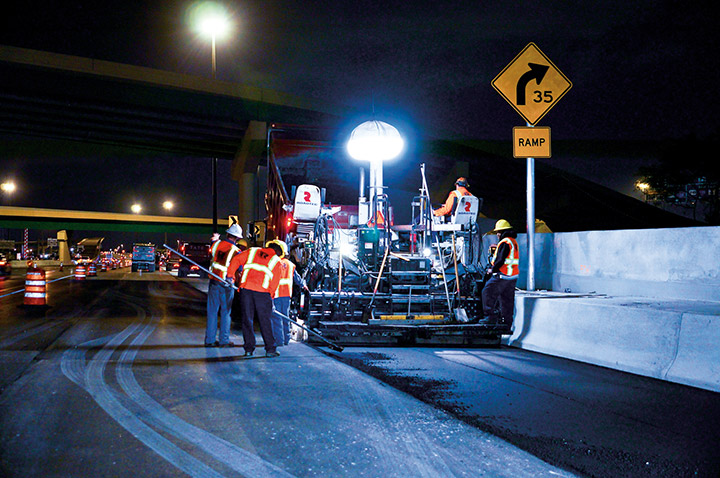Hot Mix Asphalt: The Foundation for Safe and Secure Angled Parking Lots
Wiki Article
Opening the Keys of Warm Mix Asphalt Innovation
Exploring the midsts of hot mix asphalt modern technology reveals a globe where accurate solutions and meticulous procedures converge to form our roads and infrastructure. The fusion of fillers, binders, and accumulations isn't just a building and construction job but a tactical orchestration of resilience and performance.Relevance of Warm Mix Asphalt
Hot Mix Asphalt plays a crucial function in modern-day facilities growth as a result of its toughness and cost-effectiveness. As the most frequently made use of paving material for roads, highways, and parking great deals, Warm Mix Asphalt offers a range of advantages that add to its relevance in building projects. One vital advantage is its capability to stand up to rush hour lots and harsh weather condition problems, giving a resilient and reliable surface area for transportation networks. In Addition, Warm Mix Asphalt is cost-effective in both initial building and construction and long-lasting maintenance, making it a favored option for lots of infrastructure tasks.The toughness of Hot Mix Asphalt stems from its make-up, which includes aggregates, binder, and filler materials that are meticulously chosen and blended to satisfy specific efficiency needs. Overall, the significance of Hot Mix Asphalt in infrastructure growth can not be downplayed, as it proceeds to be a cornerstone of contemporary construction techniques.
Components of Asphalt Mixes
The make-up of asphalt blends includes carefully chosen accumulations, binder, and filler materials that are vital for accomplishing certain efficiency requirements. Accumulations are the key part of asphalt blends, providing stamina and security. These accumulations can be natural, such as gravel or smashed stone, or synthetic, like recycled products from old sidewalks. The binder, generally bitumen or asphalt concrete, holds the aggregates together and supplies adaptability and durability to the mix. The option of the binder is essential as it directly affects the mix's efficiency in different weather. Fillers, such as hydrated lime or Portland cement, are utilized to enhance the mix's workability and aging resistance. Angled Parking.The mix and percentage of these elements play a considerable role in figuring out the top quality and efficiency of the asphalt mix. Engineers thoroughly develop the mix to fulfill particular requirements, considering factors like traffic quantity, climate problems, and pavement lifespan. Proper option and harmonizing of aggregates, binder, and fillers are necessary for producing resilient, long-lasting asphalt sidewalks.
Combining and Manufacturing Strategies
:max_bytes(150000):strip_icc()/low-section-of-man-working-758486719-59da6d0a054ad90010617854.jpg)
Once the aggregates are chosen, the binder, typically asphalt cement, is included in bind the materials together. The binder's quality and amount substantially affect the mix's strength, resistance, and versatility to environmental factors. Additionally, fillers like moisturized lime or Portland cement may be incorporated to improve details features of the asphalt mix, such as its workability or dampness resistance.
During production, the aggregates and binder are warmed, generally between 250-325 ° F(121-163 ° C ), to promote blending and guarantee correct finish of the accumulations. The mixing process needs to be extensive to achieve a homogeneous mix that advertises the preferred efficiency attributes of the asphalt. Various strategies, such as batch blending or drum blending, are employed to attain constant and top quality asphalt mixes for building projects.
Aspects Affecting Asphalt Performance
Aspects influencing asphalt performance incorporate an array of variables that impact the sturdiness, durability, and overall top quality of asphalt pavements. One key element is the high quality of products made use of in the asphalt mix.
Ecological conditions likewise affect asphalt performance. Temperature level variations, moisture seepage, and website traffic loads can all affect the architectural integrity of the sidewalk. Style factors to consider, such as pavement thickness and drain, are crucial in guaranteeing the lasting efficiency of the asphalt sidewalk. By carefully thinking about these variables, engineers and professionals can maximize asphalt efficiency and boost the life span of pavements.
Lasting Practices in Asphalt Innovation

WMA allows for the manufacturing and placement of asphalt blends at lower temperature levels contrasted to traditional hot-mix asphalt, resulting in minimized power intake and greenhouse gas emissions. The use of porous asphalt mixes can assist alleviate stormwater drainage issues by enabling water to penetrate via the sidewalk and right into the ground, promoting natural water purification and reenergize processes.
Conclusion
To conclude, warm mix asphalt modern technology plays a crucial role in modern infrastructure development due to its durability and cost-effectiveness. By thoroughly balancing elements, utilizing appropriate mixing techniques, and considering numerous variables, designers can produce top notch asphalt mixes that stand up to rush hour loads and harsh climate condition. Accepting sustainable techniques, such as making use of warm-mix innovations and recycled materials, further boosts the environmental friendliness of asphalt modern technology.
Blending and production strategies in hot mix asphalt modern technology entail the accurate mix and handling of aggregates, binder, and fillers to develop a resilient and high-performance asphalt mix.Factors affecting asphalt performance incorporate a variety regrading of variables that influence the toughness, longevity, and total quality of asphalt pavements. Sustainable practices in asphalt modern technology encompass numerous initiatives intended at reducing the ecological impact of asphalt manufacturing and paving procedures. By incorporating reclaimed asphalt sidewalk (RAP) and recycled asphalt shingles (RAS) right into brand-new asphalt mixes, the sector can considerably lower the consumption of raw products and energy, while also lowering landfill waste.
WMA enables for the manufacturing and placement of asphalt mixes at reduced temperature levels compared to typical hot-mix asphalt, resulting in reduced power consumption and greenhouse gas discharges.
Report this wiki page